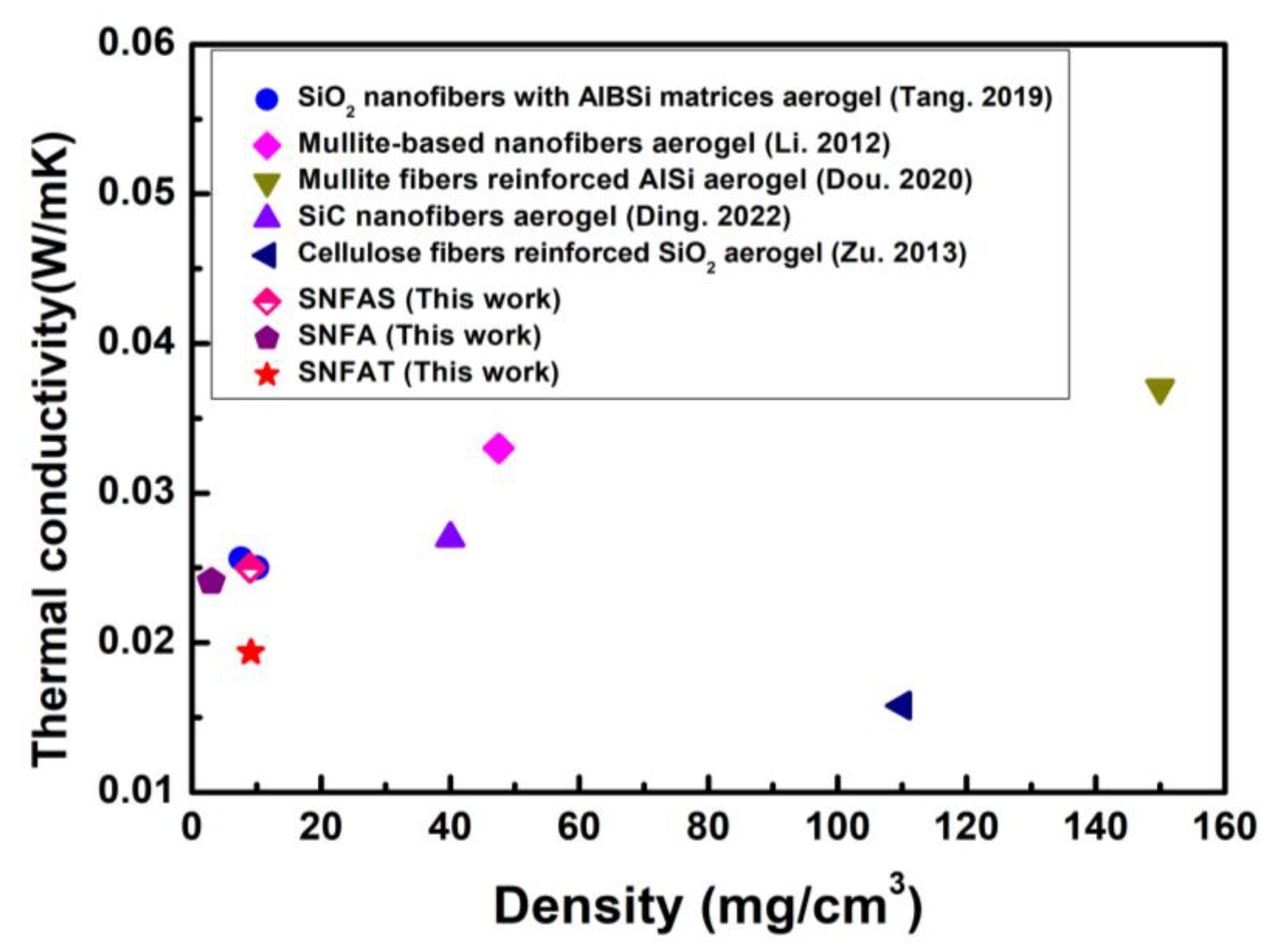Ultra-Light and Ultra-Low Thermal Conductivity of Elastic Silica Nanofibrous Aerogel with TiO2 Opacifier Particles as Filler
Abstract
1. Introduction
2. Experimental Procedure
2.1. Preparation of TiO2 Particles
2.2. Preparation of SiO2 Particles
2.3. Silica Nanofibers Prepared by Electrospinning
2.4. Preparation Process of Nanofibrous Aerogels with Particles
2.5. Characterizations
3. Results and Discussion
3.1. Micromorphology of Nanofibrous Aerogels with Particles
3.2. Mechanical Properties
3.3. Thermal Properties
3.4. Numerical Simulation of Radiative Thermal Conductivity
4. Conclusions
Author Contributions
Funding
Data Availability Statement
Conflicts of Interest
References
- Esser, B.; Barcena, J.; Kuhn, M.; Okan, A.; Haynes, L.; Gianella, S.; Ortona, A.; Liedtke, V.; Francesconi, D.; Tanno, H. Innovative Thermal Management Concepts and Material Solutions for Future Space Vehicles. J. Spacecr. Rocket. 2016, 53, 1051–1060. [Google Scholar] [CrossRef]
- Yue, C.; Feng, J.; Feng, J.; Jiang, Y. Ultralow-density and high-strength graphene aerogels composites for thermal insulation. Mater. Lett. 2017, 188, 169–171. [Google Scholar] [CrossRef]
- Blosser, M.L. Mass Efficiency Considerations for Thermally Insulated Structural Skin of an Aerospace Vehicle. J. Thermophys. Heat Transf. 2013, 27, 429–434. [Google Scholar] [CrossRef]
- Ren, H.; Wu, D.; Li, J.; Wu, W. Thermal insulation characteristics of a lightweight, porous nanomaterial in high-temperature environments. Mater. Des. 2018, 140, 376–386. [Google Scholar] [CrossRef]
- Liu, J.; Li, Y.; Li, S.; Chen, P. Novel nanometer alumina-silica insulation board with ultra-low thermal conductivity. Ceram. Int. 2022, 48, 10480–10485. [Google Scholar] [CrossRef]
- Hu, F.; Wu, S.; Sun, Y. Hollow-Structured Materials for Thermal Insulation. Adv. Mater. 2019, 31, e1801001. [Google Scholar] [CrossRef]
- Kim, J.; Lee, J.-H.; Song, T.-H. Vacuum insulation properties of phenolic foam. Int. J. Heat Mass Transf. 2012, 55, 5343–5349. [Google Scholar] [CrossRef]
- Tang, Q.; Fang, L.; Guo, W. Effects of Bamboo Fiber Length and Loading on Mechanical, Thermal and Pulverization Properties of Phenolic Foam Composites. J. Bioresour. Bioprod. 2019, 4, 51–59. [Google Scholar] [CrossRef]
- Han, Y.; Li, S.; Liu, H.; Li, Y. Lattice Boltzmann Simulation of Coupling Heat Transfer between Solid and Gas Phases of Nanoporous Materials. Nanomaterials 2022, 12, 3424. [Google Scholar] [CrossRef]
- Xu, X.; Zhang, Q.; Hao, M.; Hu, Y.; Lin, Z.; Peng, L.; Wang, T.; Ren, X.; Wang, C.; Zhao, Z.; et al. Double-negative-index ceramic aerogels for thermal superinsulation. Science 2019, 363, 723–727. [Google Scholar] [CrossRef]
- Zhao, S.; Zhang, Z.; Sèbe, G.; Wu, R.; Rivera Virtudazo, R.V.; Tingaut, P.; Koebel, M.M. Multiscale Assembly of Superinsulating Silica Aerogels Within Silylated Nanocellulosic Scaffolds: Improved Mechanical Properties Promoted by Nanoscale Chemical Compatibilization. Adv. Funct. Mater. 2015, 25, 2326–2334. [Google Scholar] [CrossRef]
- Linhares, T.; Pessoa de Amorim, M.T.; Durães, L. Silica aerogel composites with embedded fibres: A review on their preparation, properties and applications. J. Mater. Chem. A 2019, 7, 22768–22802. [Google Scholar] [CrossRef]
- Wang, L.; Feng, J.; Jiang, Y.; Li, L.; Feng, J. Elastic methyltrimethoxysilane based silica aerogels reinforced with polyvinylmethyldimethoxysilane. RSC Adv. 2019, 9, 10948–10957. [Google Scholar] [CrossRef]
- Wang, H.; Lin, S.; Yang, S.; Yang, X.; Song, J.; Wang, D.; Wang, H.; Liu, Z.; Li, B.; Fang, M.; et al. High-Temperature Particulate Matter Filtration with Resilient Yttria-Stabilized ZrO2 Nanofiber Sponge. Small 2018, 14, e1800258. [Google Scholar] [CrossRef] [PubMed]
- Yi, Z.; Zhang, X.; Yan, L.; Huyan, X.; Zhang, T.; Liu, S.; Guo, A.; Liu, J.; Hou, F. Super-insulated, flexible, and high resilient mullite fiber reinforced silica aerogel composites by interfacial modification with nanoscale mullite whisker. Compos. Part B Eng. 2022, 230, 109549. [Google Scholar] [CrossRef]
- Su, L.; Wang, H.; Niu, M.; Fan, X.; Ma, M.; Shi, Z.; Guo, S.W. Ultralight, Recoverable, and High-Temperature-Resistant SiC Nanowire Aerogel. ACS Nano 2018, 12, 3103–3111. [Google Scholar] [CrossRef]
- Si, Y.; Wang, X.; Dou, L.; Yu, J.; Ding, B. Ultralight and Fire-resistant Ceramic Nanofibrous Aerogels with Temperature-invariant Superelasticity. Sci. Adv. 2018, 4, 8925–8934. [Google Scholar] [CrossRef]
- Du, H.; Wang, S.; Xing, Y.; Li, X.; Pan, M.; Qi, W.; Ma, C. The dual effect of zirconia fiber on the insulation and mechanical performance of the fumed silica-based thermal insulation material. Ceram. Int. 2022, 48, 6657–6662. [Google Scholar] [CrossRef]
- Gaikwad, R.; Gaikwad, S.; Kim, Y.; Han, S. Electrospun fiber mats with multistep seeded growth of UTSA-16 metal organic frameworks by microwave reaction with excellent CO2 capture performance. Microporous Mesoporous Mater. 2021, 323, 111233. [Google Scholar] [CrossRef]
- Yu, Y.; Huang, Y.; Li, L.; Huang, L.; Zhang, S. Silica ceramic nanofiber membrane with ultra-softness and high temperature insulation. J. Mater. Sci. 2022, 57, 4080–4091. [Google Scholar] [CrossRef]
- Guo, J.; Fu, S.; Deng, Y.; Xu, X.; Laima, S.; Liu, D.; Zhang, P.; Zhou, J.; Zhao, H.; Yu, H.; et al. Hypocrystalline ceramic aerogels for thermal insulation at extreme conditions. Nature 2022, 606, 909–916. [Google Scholar] [CrossRef]
- Zhang, H.; Fang, W.-Z.; Wang, X.; Li, Y.-M.; Tao, W.-Q. Thermal conductivity of fiber and opacifier loaded silica aerogel composite. Int. J. Heat Mass Transf. 2017, 115, 21–31. [Google Scholar] [CrossRef]
- Zhang, H.; Zhang, C.; Ji, W.; Wang, X.; Li, Y.; Tao, W. Experimental Characterization of the Thermal Conductivity and Microstructure of Opacifier-Fiber-Aerogel Composite. Molecules 2018, 23, 2198. [Google Scholar] [CrossRef]
- Wang, X.-D.; Sun, D.; Duan, Y.-Y.; Hu, Z.-J. Radiative characteristics of opacifier-loaded silica aerogel composites. J. Non-Cryst. Solids 2013, 375, 31–39. [Google Scholar] [CrossRef]
- Wang, J.; Kuhn, j.; Lu, X. Monolithic silica aerogel insulation doped with TiO 2 powder and ceramic fibers. J. Non-Cryst. Solids 1995, 186, 296–300. [Google Scholar] [CrossRef]
- Xu, L.; Jiang, Y.; Feng, J.; Feng, J.; Yue, C. Infrared-opacified Al2O3–SiO2 aerogel composites reinforced by SiC-coated mullite fibers for thermal insulations. Ceram. Int. 2015, 41, 437–442. [Google Scholar] [CrossRef]
- Zou, W.; Wang, X.; Wu, Y.; Zou, L.; Zu, G.; Chen, D.; Shen, J. Opacifier embedded and fiber reinforced alumina-based aerogel composites for ultra-high temperature thermal insulation. Ceram. Int. 2019, 45, 644–650. [Google Scholar] [CrossRef]
- Zhang, H.-X.; He, X.-D.; He, F. Microstructural characterization and properties of ambient-dried SiO2 matrix aerogel doped with opacified TiO2 powder. J. Alloys Compd. 2009, 469, 366–369. [Google Scholar] [CrossRef]
- Zhao, J.-J.; Duan, Y.-Y.; Wang, X.-D.; Zhang, X.-R.; Han, Y.-H.; Gao, Y.-B.; Lv, Z.-H.; Yu, H.-T.; Wang, B.-X. Optical and radiative properties of infrared opacifier particles loaded in silica aerogels for high temperature thermal insulation. Int. J. Therm. Sci. 2013, 70, 54–64. [Google Scholar] [CrossRef]
- Hao-Qiang, P.; Zeng-Yao, L. Experimental investigations on the thermal insulation performance of SiC opacifier doped silica aerogel at large temperature difference. Int. J. Therm. Sci. 2021, 160, 106681. [Google Scholar] [CrossRef]
- Zhu, C.-Y.; Li, Z.-Y.; Pan, N. Design and thermal insulation performance analysis of endothermic opacifiers doped silica aerogels. Int. J. Therm. Sci. 2019, 145, 105995. [Google Scholar] [CrossRef]
- Feng, J.; Wang, Y.; Feng, X.; Huang, Q.; Ma, S.; Mo, W.; Yang, J.; Su, X.; Lin, M. Radiative heat attenuation mechanisms for nanoporous thermal insulating composites. Appl. Therm. Eng. 2016, 105, 39–45. [Google Scholar] [CrossRef]
- Tang, G.H.; Zhao, Y.; Guo, J.F. Multi-layer graded doping in silica aerogel insulation with temperature gradient. Int. J. Heat Mass Transf. 2016, 99, 192–200. [Google Scholar] [CrossRef]
- Tang, G.H.; Bi, C.; Zhao, Y.; Tao, W.Q. Thermal transport in nano-porous insulation of aerogel: Factors, models and outlook. Energy 2015, 90, 701–721. [Google Scholar] [CrossRef]
- He, Y.-L.; Xie, T. Advances of thermal conductivity models of nanoscale silica aerogel insulation material. Appl. Therm. Eng. 2015, 81, 28–50. [Google Scholar] [CrossRef]
- Iswar, S.; Griffa, M.; Kaufmann, R.; Beltran, M.; Huber, L.; Brunner, S.; Lattuada, M.; Koebel, M.M.; Malfait, W.J. Effect of aging on thermal conductivity of fiber-reinforced aerogel composites: An X-ray tomography study. Microporous Mesoporous Mater. 2019, 278, 289–296. [Google Scholar] [CrossRef]
- Aegerter, M.A.; Leventis, N.; Koebel, M.M. History of Aerogels. In Aerogels Handbook; Aegerter, M.A., Prassas, M., Eds.; Springer: New York, NY, USA, 2011; pp. 3–18. [Google Scholar]
- Lu, X.; Arduini-Schuster, M.C.; Kuhn, J.; Nilsson, O.; Fricke, J.; Pekala, R.W. Thermal Conductivity of Monolithic Organic Aerogels. Science 1992, 225, 971–972. [Google Scholar] [CrossRef]
- Li, X.; Yang, R. Effect of lattice mismatch on phonon transmission and interface thermal conductance across dissimilar material interfaces. Phys. Rev. B 2012, 8, 054305. [Google Scholar] [CrossRef]
- Dou, L. Fabrication and Thermal Insulation Properties of Silica Nanofiber based Aerogels with Superelasticity. Ph.D. Thesis, Donghua University, Shanghai, China, 2020. [Google Scholar]
- Ding, W.; Li, H.; Liu, H.; Li, Q.; Wu, Y. Fiber of bioinspired columnar cactus prickle-like structure for reinforced SiC aerogel: Thermal insulation and mechanical properties. J. Eur. Ceram. Soc. 2022, 42, 5438–5447. [Google Scholar] [CrossRef]
- Zu, G.; Shen, J.; Zou, L.; Wang, W.; Lian, Y.; Zhang, Z.; Du, A. Nanoengineering Super Heat-Resistant, Strong Alumina Aerogels. Chem. Mater. 2013, 25, 4757–4764. [Google Scholar] [CrossRef]
- Si, Y.; Wang, X.; Yan, C.; Yang, L.; Yu, J.; Ding, B. Ultralight Biomass-Derived Carbonaceous Nanofibrous Aerogels with Superelasticity and High Pressure-Sensitivity. Adv. Mater. 2016, 28, 9512–9518. [Google Scholar] [CrossRef] [PubMed]
- Dou, L.; Zhang, X.; Shan, H.; Cheng, X.; Si, Y.; Yu, J.; Ding, B. Interweaved Cellular Structured Ceramic Nanofibrous Aerogels with Superior Bendability and Compressibility. Adv. Funct. Mater. 2020, 30, 2005928. [Google Scholar] [CrossRef]
- Thangavel, R.; Ahilan, V.; Moorthy, M.; Yoon, W.-S.; Shanmugam, S.; Lee, Y.-S. Flexible quasi-solid-state lithium-ion capacitors employing amorphous SiO2 nanospheres encapsulated in nitrogen-doped carbon shell as a high energy anode. J. Power Sources 2021, 48, 229143. [Google Scholar] [CrossRef]
- Gao, Z. Research on TiO2 Single Crystals Inherited from Amorphous TiO2 Nanotubes and Their Electrochemical Capacitance Performance; Tianjin University: Tianjin, China, 2016. [Google Scholar]
- Keri, O.; Kocsis, E.; Karajz, D.A.; Nagy, Z.K.; Parditka, B.; Erdelyi, Z.; Szabo, A.; Hernadi, K.; Szilagyi, I.M. Photocatalytic Crystalline and Amorphous TiO2 Nanotubes Prepared by Electrospinning and Atomic Layer Deposition. Molecules 2021, 26, 6917. [Google Scholar] [CrossRef] [PubMed]
- Zhang, B.; Wang, W.; Tong, Z.; Xu, H.; Li, X.; Ji, H. Design and preparation of hollow SiO2 nanospheres/SiC-based nanocomposite fiber membrane for high temperature thermal insulators. Microporous Mesoporous Mater. 2022, 329, 111551. [Google Scholar] [CrossRef]
- Song, J.; Wang, X.; Yan, J.; Yu, J.; Sun, G.; Ding, B. Soft Zr-doped TiO2 Nanofibrous Membranes with Enhanced Photocatalytic Activity for Water Purification. Sci. Rep. 2017, 7, 1636. [Google Scholar] [CrossRef]
- Cao, L.; Shan, H.; Zong, D.; Yu, X.; Yin, X.; Si, Y.; Yu, J.; Ding, B. Fire-Resistant and Hierarchically Structured Elastic Ceramic Nanofibrous Aerogels for Efficient Low-Frequency Noise Reduction. Nano Lett. 2022, 22, 1609–1617. [Google Scholar] [CrossRef]
- Schuh, C.A.; Lund, A.C. Atomistic basis for the plastic yield criterion of metallic glass. Nat. Mater. 2003, 2, 449–452. [Google Scholar] [CrossRef]
- Yu, Z.L.; Yang, N.; Apostolopoulou-Kalkavoura, V.; Qin, B.; Ma, Z.Y.; Xing, W.Y.; Qiao, C.; Bergstrom, L.; Antonietti, M.; Yu, S.H. Fire-Retardant and Thermally Insulating Phenolic-Silica Aerogels. Angew. Chem. Int. Ed. Engl. 2018, 57, 4538–4542. [Google Scholar] [CrossRef]
- Hayase, G.; Kugimiya, K.; Ogawa, M.; Kodera, Y.; Kanamori, K.; Nakanishi, K. The thermal conductivity of polymethylsilsesquioxane aerogels and xerogels with varied pore sizes for practical application as thermal superinsulators. J. Mater. Chem. A 2014, 2, 6525–6531. [Google Scholar] [CrossRef]
- Wicklein, B.; Kocjan, A.; Salazar-Alvarez, G.; Carosio, F.; Camino, G.; Antonietti, M.; Bergstrom, L. Thermally insulating and fire-retardant lightweight anisotropic foams based on nanocellulose and graphene oxide. Nat. Nanotechnol. 2015, 10, 277–283. [Google Scholar] [CrossRef] [PubMed]
- Litovsky, E.; Shapiro, M.; Shavit, A. Gas pressure and temperature dependences of thermal conductivity of porous ceramic materials: Part 2, refractories and ceramics with porosity exceeding 30%. J. Am. Ceram. Soc. 1996, 79, 1366–1376. [Google Scholar] [CrossRef]
- Zhang, B.; Liu, Y.; Li, X.; Su, D.; Ji, H. Closed-cell ZrO2/SiC-based composite nanofibers with efficient electromagnetic wave absorption and thermal insulation properties. J. Alloys Compd. 2022, 927, 167036. [Google Scholar] [CrossRef]
- Elishav, O.; Beilin, V.; Rozent, O.; Shter, G.E.; Grader, G.S. Thermal shrinkage of electrospun PVP nanofibers. J. Polym. Sci. Part B Polym. Phys. 2018, 56, 248–254. [Google Scholar] [CrossRef]
- Zhang, B.; Liu, Y.; Wu, Q.; Zhou, M.; Su, D.; Ji, H.; Li, X. Super-insulating, ultralight and high-strength mullite-based nanofiber composite aerogels. J. Eur. Ceram. Soc. 2022, 42, 5995–6004. [Google Scholar] [CrossRef]
- Peng, F.; Jiang, Y.; Feng, J.; Cai, H.; Feng, J.; Li, L. Thermally insulating, fiber-reinforced alumina–silica aerogel composites with ultra-low shrinkage up to 1500 °C. Chem. Eng. J. 2021, 411, 128402. [Google Scholar] [CrossRef]
- Quan, J.; Lan, X.; Lim, G.J.H.; Hou, Y.; Yang, Y.; Khoo, B.C. Hierarchical SiC fiber aerogel toward microwave attenuation and thermal insulation application. J. Alloys Compd. 2022, 911, 165097. [Google Scholar] [CrossRef]
- Jaxel, J.; Markevicius, G.; Rigacci, A.; Budtova, T. Thermal superinsulating silica aerogels reinforced with short man-made cellulose fibers. Compos. Part A Appl. Sci. Manuf. 2017, 103, 113–121. [Google Scholar] [CrossRef]
- Caps, R.; Fricke, J.P.D.; Reiss, H. Improving the extinction properties of an evacuated high-temperature powder insulation. High Temp.-High Press. 1983, 15, 225–232. [Google Scholar]
- Singh, H.; Geisler, M.; Menzel, F. Experimental investigations into thermal transport phenomena in vacuum insulation panels (VIPs) using fumed silica cores. Energy Build. 2015, 107, 76–83. [Google Scholar] [CrossRef]
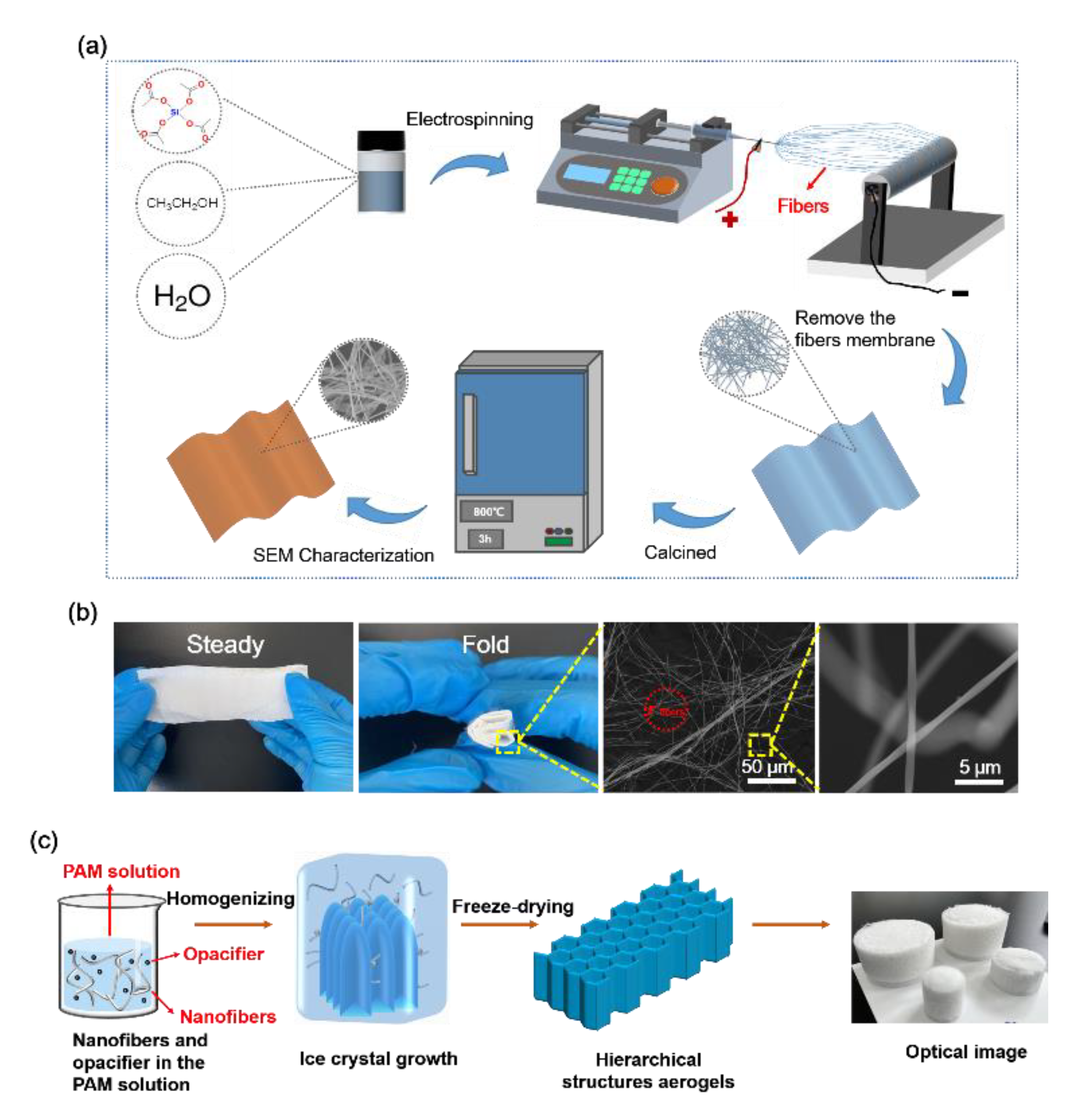
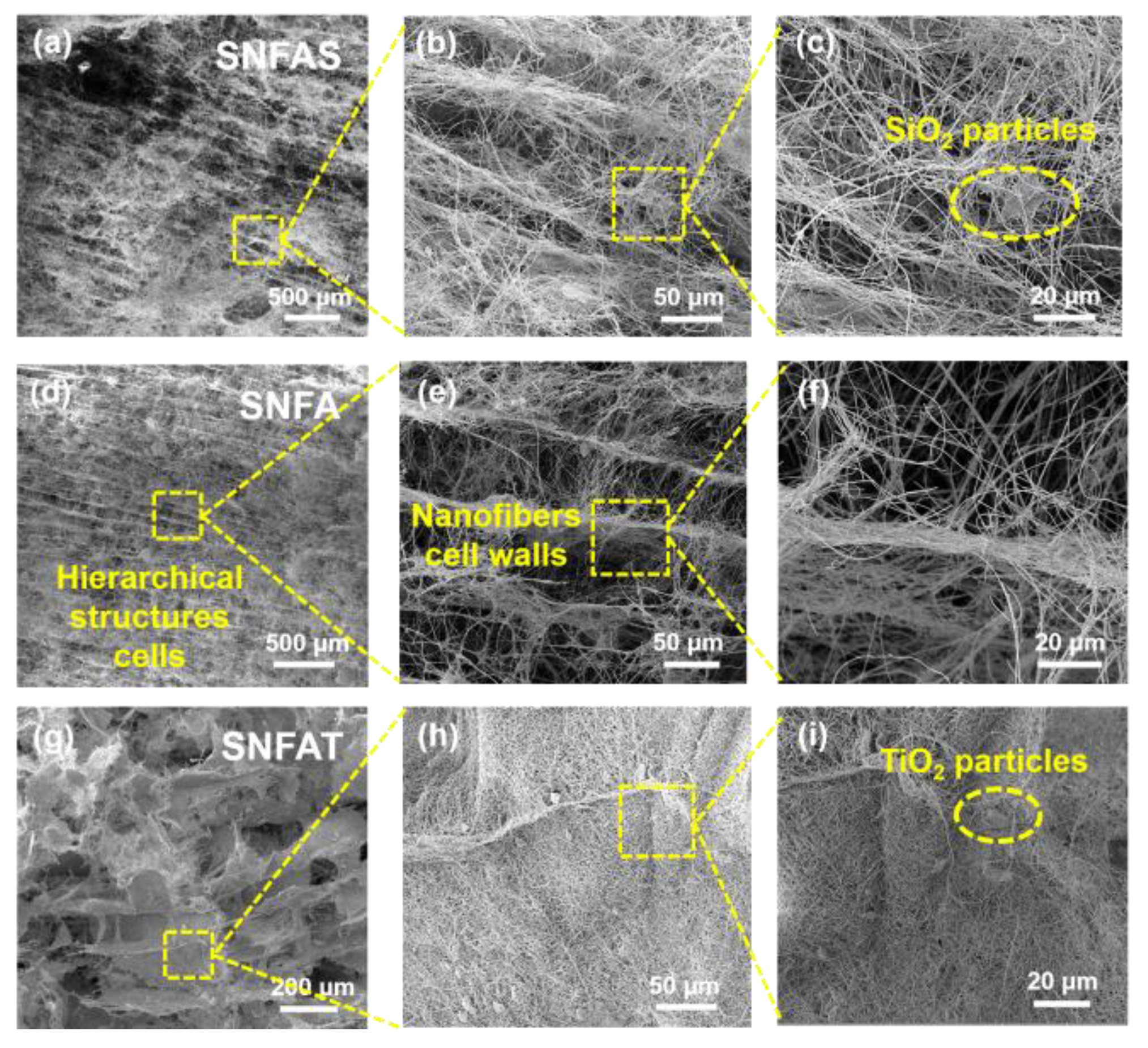
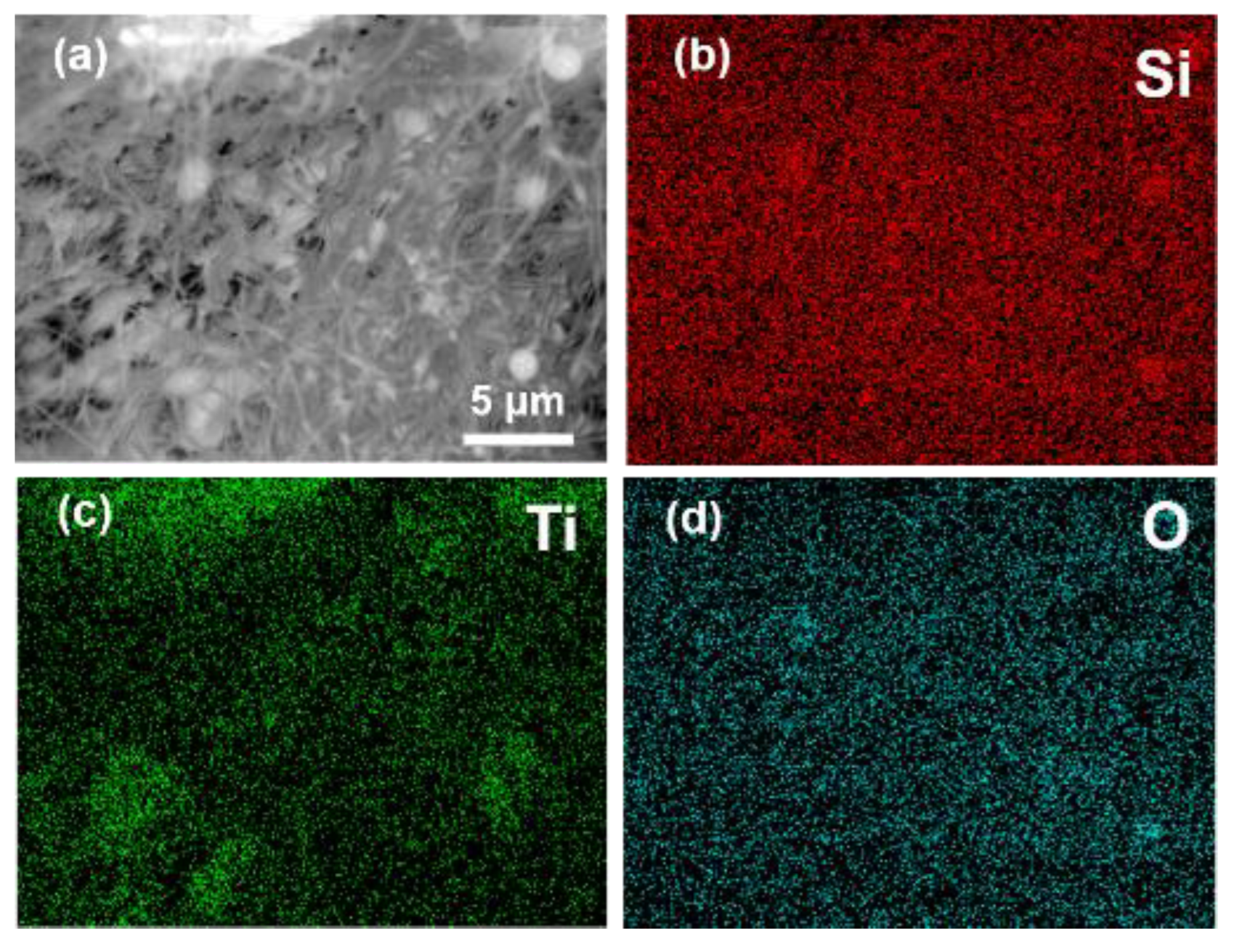

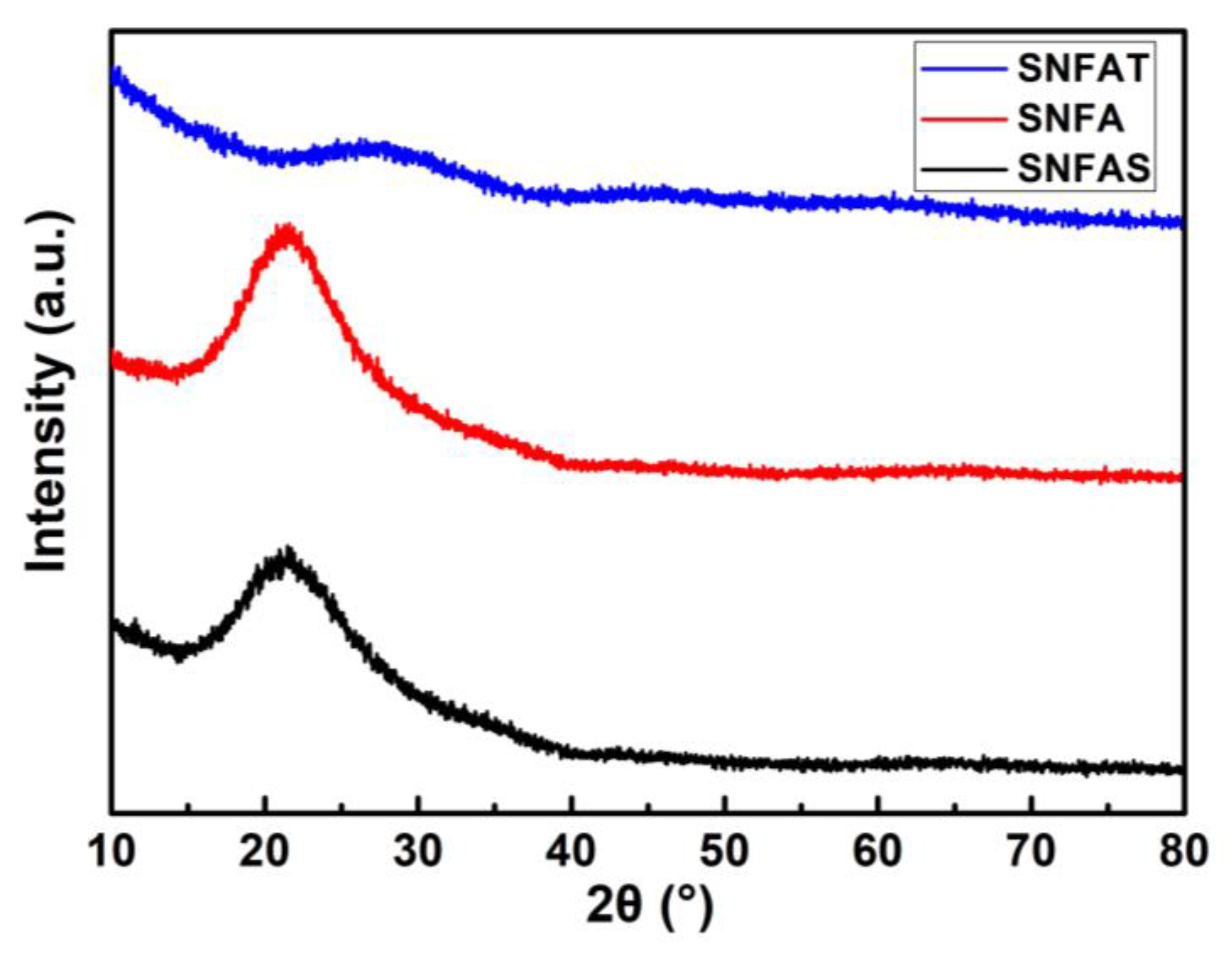


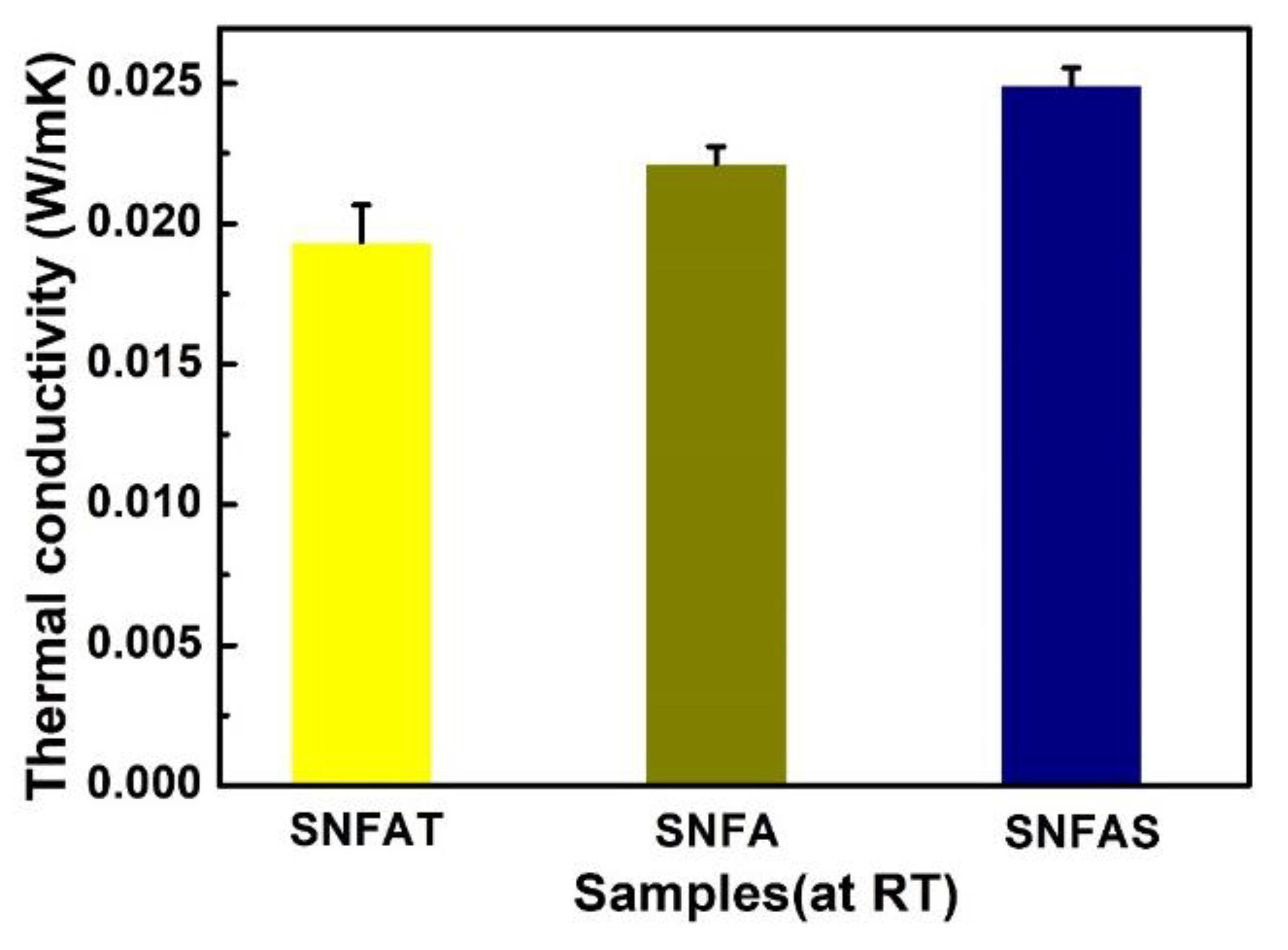



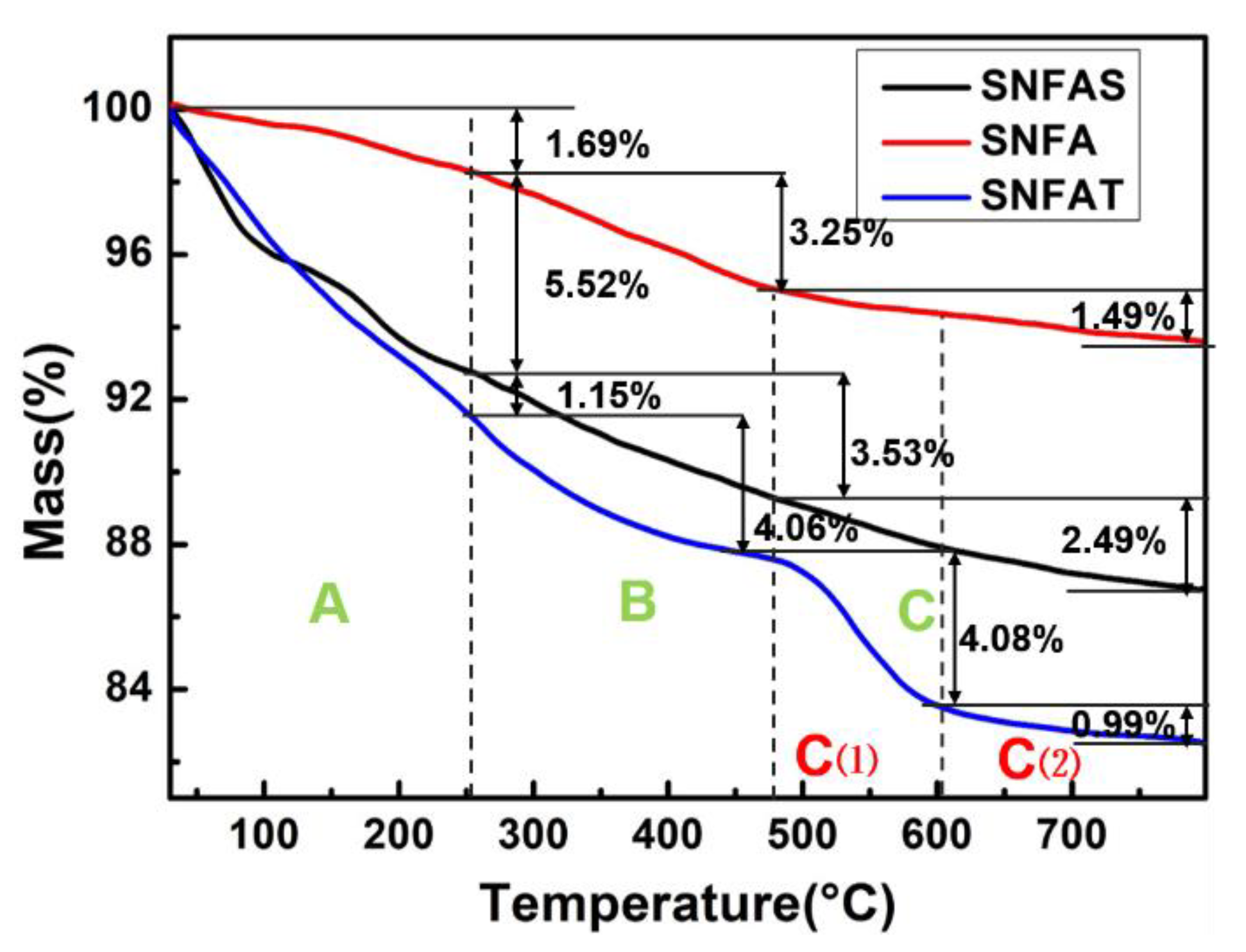
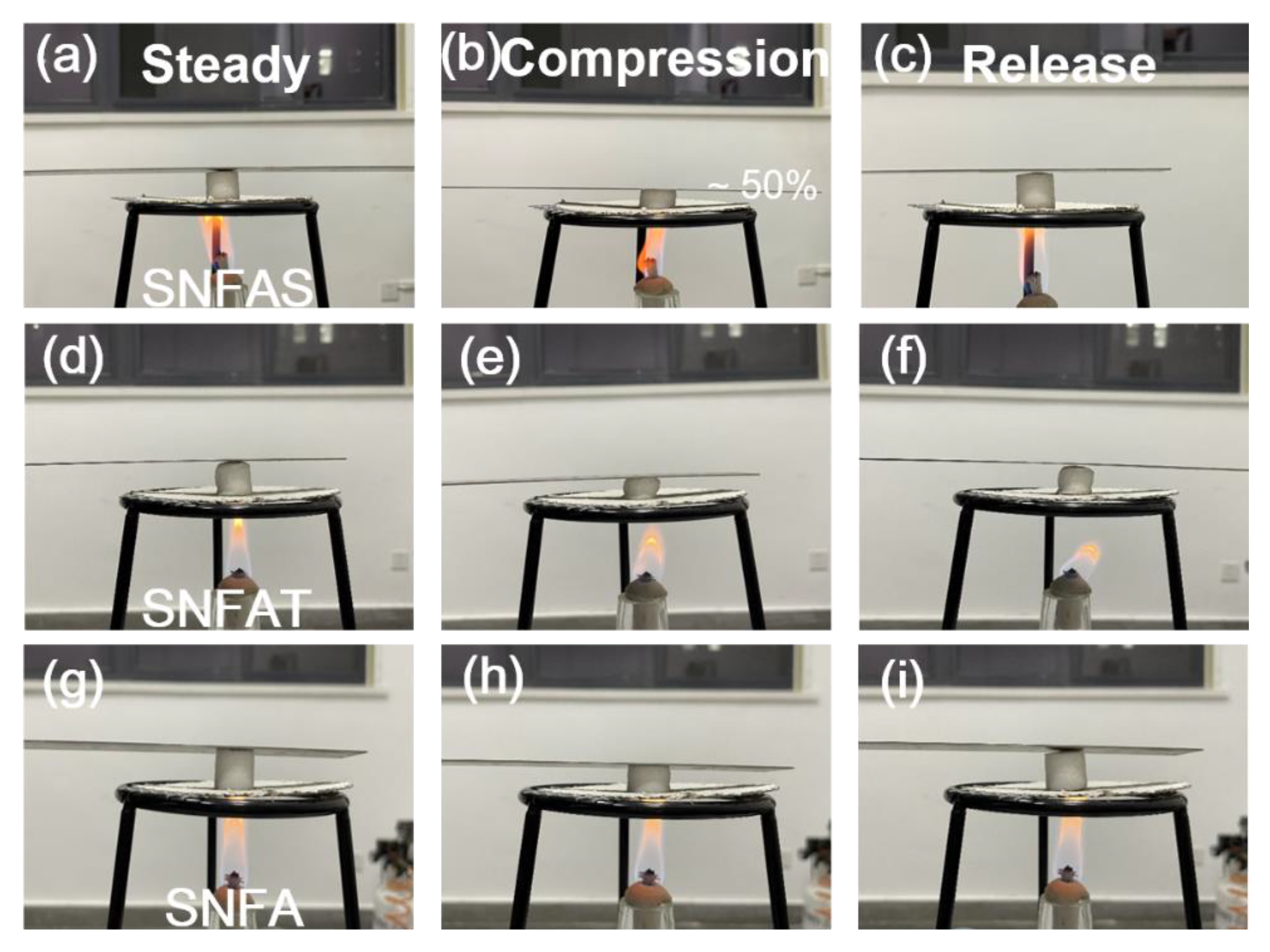
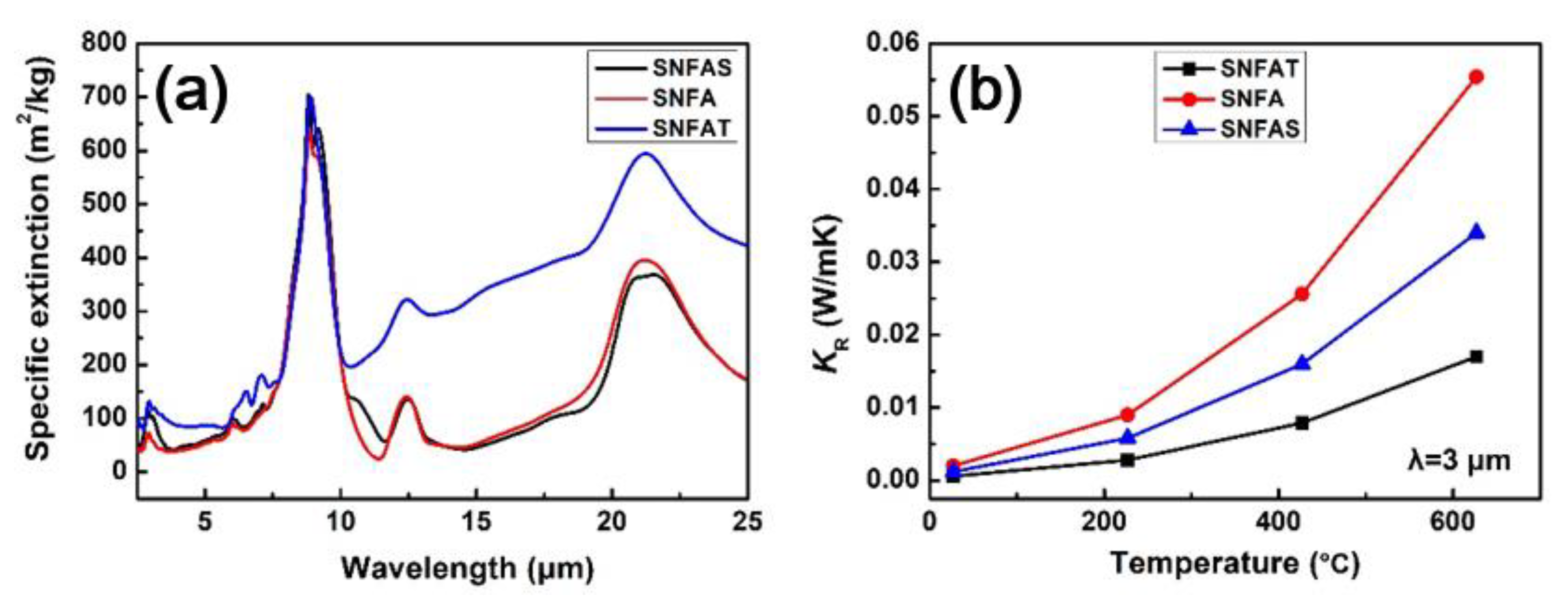
Publisher’s Note: MDPI stays neutral with regard to jurisdictional claims in published maps and institutional affiliations. |
© 2022 by the authors. Licensee MDPI, Basel, Switzerland. This article is an open access article distributed under the terms and conditions of the Creative Commons Attribution (CC BY) license (https://creativecommons.org/licenses/by/4.0/).
Share and Cite
Yang, L.; Ding, Y.; Yang, M.; Wang, Y.; Erişen, D.E.; Chen, Z.; Wu, Q.; Zheng, G. Ultra-Light and Ultra-Low Thermal Conductivity of Elastic Silica Nanofibrous Aerogel with TiO2 Opacifier Particles as Filler. Nanomaterials 2022, 12, 3928. https://doi.org/10.3390/nano12223928
Yang L, Ding Y, Yang M, Wang Y, Erişen DE, Chen Z, Wu Q, Zheng G. Ultra-Light and Ultra-Low Thermal Conductivity of Elastic Silica Nanofibrous Aerogel with TiO2 Opacifier Particles as Filler. Nanomaterials. 2022; 12(22):3928. https://doi.org/10.3390/nano12223928
Chicago/Turabian StyleYang, Lixia, Yang Ding, Mengmeng Yang, Yapeng Wang, Deniz Eren Erişen, Zhaofeng Chen, Qiong Wu, and Guiyuan Zheng. 2022. "Ultra-Light and Ultra-Low Thermal Conductivity of Elastic Silica Nanofibrous Aerogel with TiO2 Opacifier Particles as Filler" Nanomaterials 12, no. 22: 3928. https://doi.org/10.3390/nano12223928
APA StyleYang, L., Ding, Y., Yang, M., Wang, Y., Erişen, D. E., Chen, Z., Wu, Q., & Zheng, G. (2022). Ultra-Light and Ultra-Low Thermal Conductivity of Elastic Silica Nanofibrous Aerogel with TiO2 Opacifier Particles as Filler. Nanomaterials, 12(22), 3928. https://doi.org/10.3390/nano12223928








